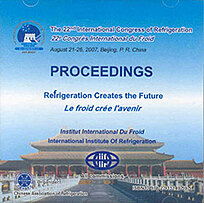
IIR document
A study on temperature separation in the vortex tube.
Author(s) : KAEWKAOKIET Y., EIAMSA-ARD S., PIMSARN M., et al.
Summary
This paper reports that increasing the number of inlet nozzles in both insulated and non-insulated vortex tubes affects the temperature distribution and causes temperature reduction in the counter flow vortex tube. From experiments with vortex tubes of 16 mm diameter and cold orifice diameter of 0.5D, we found the maximum temperature reductions at the core for 1,2 and 4 inlet nozzles respectively to be -16, -29 and -30°C. In addition, the cold air temperature drop from employing the snail is higher than those from employing the tangential inlet with 1, 2 and 4 nozzles at the same inlet pressure. For applying the snail to the vortex tube, the maximum cold air temperature reduction and the isentropic efficiency are found to be 33°C and 36%, respectively. Applying dimensional analysis and similarity geometry yielded an empirical correlation for use in designing vortex tubes for optimal performance.
Available documents
Format PDF
Pages: ICR07-E2-656
Available
Public price
20 €
Member price*
Free
* Best rate depending on membership category (see the detailed benefits of individual and corporate memberships).
Details
- Original title: A study on temperature separation in the vortex tube.
- Record ID : 2008-0660
- Languages: English
- Source: ICR 2007. Refrigeration Creates the Future. Proceedings of the 22nd IIR International Congress of Refrigeration.
- Publication date: 2007/08/21
Links
See other articles from the proceedings (839)
See the conference proceedings
-
Parametric study of a Ranque-Hilsch or vortex t...
- Author(s) : ROCHA M. S., POLISEL R. A., SIMÕES-MOREIRA J. R.
- Date : 2007/08/21
- Languages : English
- Source: ICR 2007. Refrigeration Creates the Future. Proceedings of the 22nd IIR International Congress of Refrigeration.
- Formats : PDF
View record
-
Numerical simulation of turbulent compressible ...
- Author(s) : CAO Y., QI Y. F., LIU J. Y., et al.
- Date : 2003/04/22
- Languages : English
- Source: Cryogenics and refrigeration. Proceedings of ICCR 2003.
View record
-
Simulation of thermal separation in a high-velo...
- Author(s) : EIAMSA-ARD S., PETHKOOL S., PROMVONGE P.
- Date : 2007/08/21
- Languages : English
- Source: ICR 2007. Refrigeration Creates the Future. Proceedings of the 22nd IIR International Congress of Refrigeration.
- Formats : PDF
View record
-
An experimental investigation of the optimum ge...
- Author(s) : VILHEKAR R., AGRAWAL N., NAIK S.
- Date : 2015/08/16
- Languages : English
- Source: Proceedings of the 24th IIR International Congress of Refrigeration: Yokohama, Japan, August 16-22, 2015.
- Formats : PDF
View record
-
Cascade refrigerators with vortex tube stage.
- Author(s) : ARKHAROV I. A., LUCKYANOV P. A., NAVASARDYAN E. S., et al.
- Date : 2003/08/17
- Languages : English
- Source: 21st IIR International Congress of Refrigeration: Serving the Needs of Mankind.
- Formats : PDF
View record
